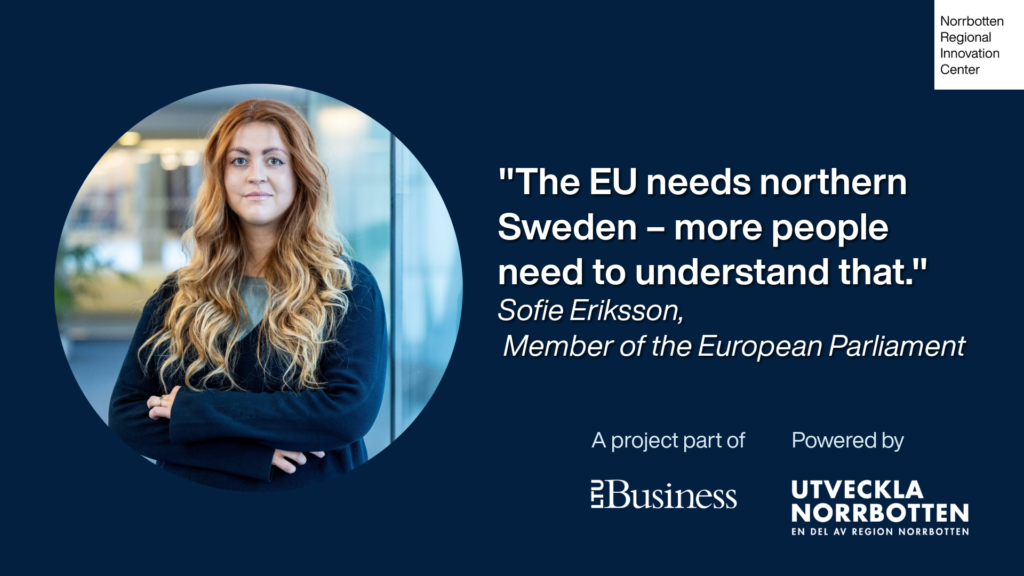Cold, Remote, Connected: Europe’s Arctic wireless platform is a demonstration of place-based innovation and interregional cooperation

The coming release of OECD report “Building Resilience to Global Transition in the Northern Sparsely Populated Areas” provides crucial insights and over 100 recommendations for Norrbotten and 13 neighbouring regions in Sweden, Finland, and Norway that make up the NSPA (Northern Sparsely Populated Areas).
It highlights both shared challenges and unique opportunities for innovation, sustainability, and economic development in the European Arctic. In light of the report, there are also important lessons on building cross-border innovation ecosystems that other EU regions should take inspiration from.
Sofie Eriksson, MEP, highlights the importance of raising awareness in EU about northern Sweden:
– The EU needs northern Sweden – more people need to understand that. Without the raw materials, experience, and expertise from these regions, industry on the continent won’t function either. It is crucial that the OECD, given its position, highlights how much northern Sweden contributes and that there is, therefore, a shared EU interest in ensuring that the region can truly thrive.
Innovation by necessity: How local conditions in northern Scandinavia drive wireless breakthroughs
Northern Scandinavia’s harsh climate, vast distances, and sparse population pose significant challenges—but also drive groundbreaking wireless innovation.
For more than thirty years, the mantra of Luleå University of Technology’s Center for Distance-Spanning Technology has been “better than being there” – striving to develop technology that is state-of-the-art when it comes to overcoming physical distance.
This mission coupled with bold and early investments in broadband infrastructure made the Norrbotten region a pioneer in developing and deploying virtual meetings, leading to university spinoff Marratech that was purchased by Google in 2009.

When conventional solutions fail, necessity sparks new technology, making the region a leader in broadband expansion, autonomous transport, and satellite communication.
Cross-border collaboration between academia, industry, and policymakers has turned this remote area into a testbed for cutting-edge solutions, offering valuable insights for the EU regional innovation community.
– Digitalization is key to quality of life and societal development in rural areas. Yet, as a consumer market, our local geography and demographic conditions require technology adaptions or even brand new solutions. We partner researchers and labs with the needs owners, business sector and funding agencies to make it happen, says Björn Backe, Director of the Center for Distance- Spanning Technology at Luleå University of Technology.
Technology for communities, industries and local businesses
New wireless industrial applications see the light of day in the underground testbed, the forthcoming 6G test site or the NorthStar Innovation Programme, developed jointly with industry partners and sector technology providers.
In other projects, researchers collaborate with Baltic regions to upscale smart cities into smart regions; and work with local authorities in northern Sweden to explore ways to improve public services such as mobility and accessibility to transport in rural areas.
Supporting resilience and competitiveness in the local business community, the university also run tailored projects such as Green Transition North, raising awareness and supporting the local small- and medium enterprises with advanced technology that allows for circular supply chains and fossilfree energy systems.
Cross-Border Collaboration as a Success Model
Strong Nordic cooperation fuels innovation. Institutions like the University of Oulu and Luleå University of Technology, alongside companies like Ericsson, ABB and Telia, pioneer wireless advancements. The early 2000s Living Labs initiative made Norrbotten a global digitalization leader, proving that user-driven innovation can accelerate EU-wide R&D success.
The engagement from these stakeholders is a thriving nursery for tech SMEs, supported by the local and regional governments by creating physical innovation environments close to academia, as well as anchoring wireless technology in long-term strategies for the region, such as the smart specialization strategy for Norrbotten.
Another example of the close collaboration between the regions is the joint leadership of the European S3-partnership on wireless technology as well as an impressive portfolio of Interreg and I3 projects.
The Future of Arctic Connectivity
Michael Nilsson has a long experience driving wireless technology innovation ecosystems, currently in the realm of Center for Distance-Spanning Technology. For the future of connectivity in the Arctic – and Europe – he champions SME support, collaboration and place-based approach to harness the opportunities.

– The transition to 6G will expand possibilities in e-health, autonomous systems, and creative industries like AR/VR. Security and resilience will also be at the forefront of future innovations. Cybersecurity measures must ensure that autonomous systems —whether in transportation, industry, or energy—operate without exposure to external threats. The EU’s ongoing work on digital resilience strategies can benefit from the region’s experience in building secure, high-performance networks in extreme conditions.
By embracing this approach, the EU can strengthen its leadership in next-generation digital technology. Northern Scandinavia exemplifies how necessity drives technological breakthroughs, with its self-reliant yet collaborative model proving that innovation flourishes at the intersection of resilience, cooperation, and forward-thinking policy.
However, for these innovations to spread across the region and achieve widespread adoption, more is needed. Norrbotten alone spans an area three times the size of Belgium and relies heavily on exports.
To ensure that innovative companies and emerging sectors in the region remain competitive, critical infrastructure investments—such as resilient wireless networks and 5G corridors—are essential.
Are you a fan of regional innovation?
Norrbotten Regional Innovation Center is a collaborative platform to accelerate societal transformation in a smart and sustainable way. This will be done through inter-regional European co-operation.


